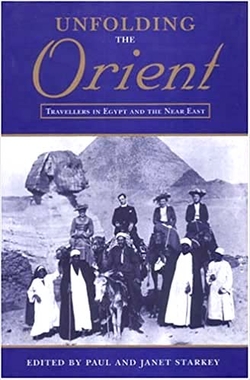 Many of the chapters in these companion volumes (which are in rough chronological order) offer pleasant but routine accounts of Europe travelers to the Middle East in past centuries. Some, however, rise above the ordinary to provide real insight into relations between the two civilizations. Philip Mansel's essay on the Grand Tour to the Ottoman Empire conveys the cheerful sense of superiority Europeans felt toward Middle Easterners ("the dear Arabians and Turks are quite darlings," was the 1816 comment of the princess of Wales while visiting their dear countries). Mary Ann Fey shows the striking contrast between the observations of Turkey by Lady Mary Wortley Montagu in 1716-18 and those of her male contemporaries; they saw nothing but subjugation of Muslim women but she appreciated their ability to own property (precisely because she lacked this right) and ended up calling the Turkish females "(perhaps) freer than any ladies in the universe."
Many of the chapters in these companion volumes (which are in rough chronological order) offer pleasant but routine accounts of Europe travelers to the Middle East in past centuries. Some, however, rise above the ordinary to provide real insight into relations between the two civilizations. Philip Mansel's essay on the Grand Tour to the Ottoman Empire conveys the cheerful sense of superiority Europeans felt toward Middle Easterners ("the dear Arabians and Turks are quite darlings," was the 1816 comment of the princess of Wales while visiting their dear countries). Mary Ann Fey shows the striking contrast between the observations of Turkey by Lady Mary Wortley Montagu in 1716-18 and those of her male contemporaries; they saw nothing but subjugation of Muslim women but she appreciated their ability to own property (precisely because she lacked this right) and ended up calling the Turkish females "(perhaps) freer than any ladies in the universe."
 The startling chapter by Neil Cooke delves into the practice of some male Britons in Egypt to buy themselves female slaves; he focuses on a man who at times offered their favors to his friends and ended taking one of them back with him to the United Kingdom, where she lived out her days, dying in 1883. Nadia Gindy analyses Anthony Trollope's two slight but amusing stories about British tourists to Egypt based on his time there, with an emphasis on characteristically Trollopian humor (a Western woman who hands out baksheesh by the Pyramids resembles "a piece of sugar covered with flies"; she later explains that "she would not go to the Pyramids again, not if they were to be given to her for herself as ornaments for her garden").
The startling chapter by Neil Cooke delves into the practice of some male Britons in Egypt to buy themselves female slaves; he focuses on a man who at times offered their favors to his friends and ended taking one of them back with him to the United Kingdom, where she lived out her days, dying in 1883. Nadia Gindy analyses Anthony Trollope's two slight but amusing stories about British tourists to Egypt based on his time there, with an emphasis on characteristically Trollopian humor (a Western woman who hands out baksheesh by the Pyramids resembles "a piece of sugar covered with flies"; she later explains that "she would not go to the Pyramids again, not if they were to be given to her for herself as ornaments for her garden").
The set's tour de force is a long inquiry by John Rodenbeck into the European habit of dressing like Turks and Arabs. Starting with a quote from the invariably wrong analysis of Edward Said that this was a source of "secret European power," Rodenbeck goes on, through a dazzling display of quotations and other references, to show the true reasons for this custom. The main one was safety; to dress in Western style before 1850 was to court danger. Sometimes (as for women in Saudi Arabia, Iran, and Afghanistan today), the reason was to comply with local regulations. Or it had to do with fashion or bravura or seduction. The one things it did not have to do with, contrary to the ignorant theorizing of Said and his minions, was spying or displaying cultural aggression.